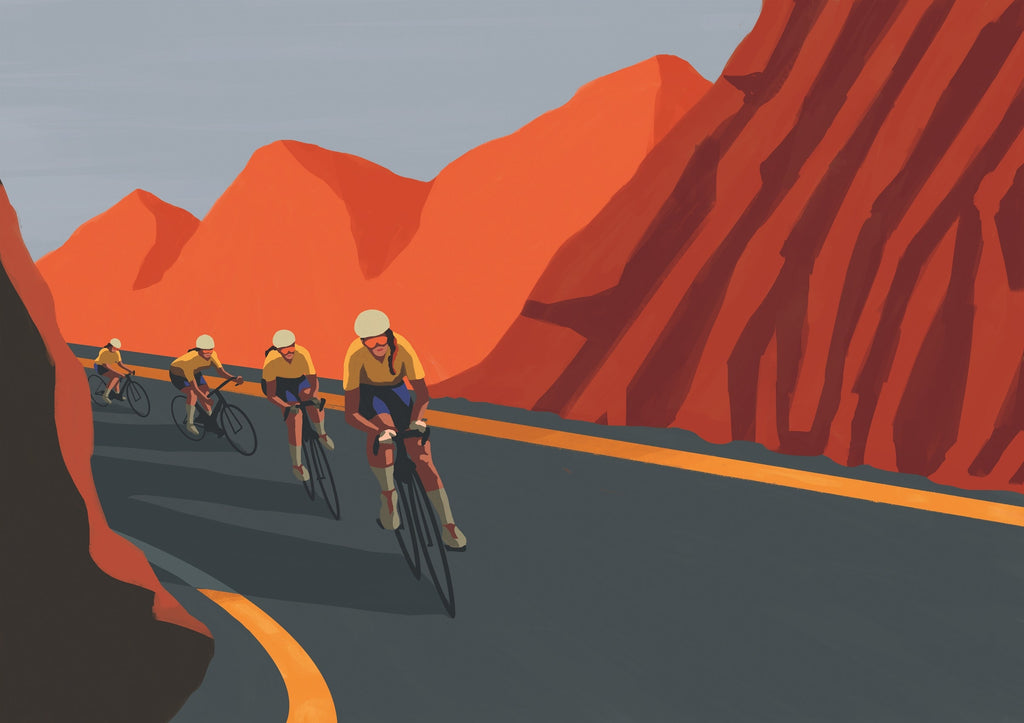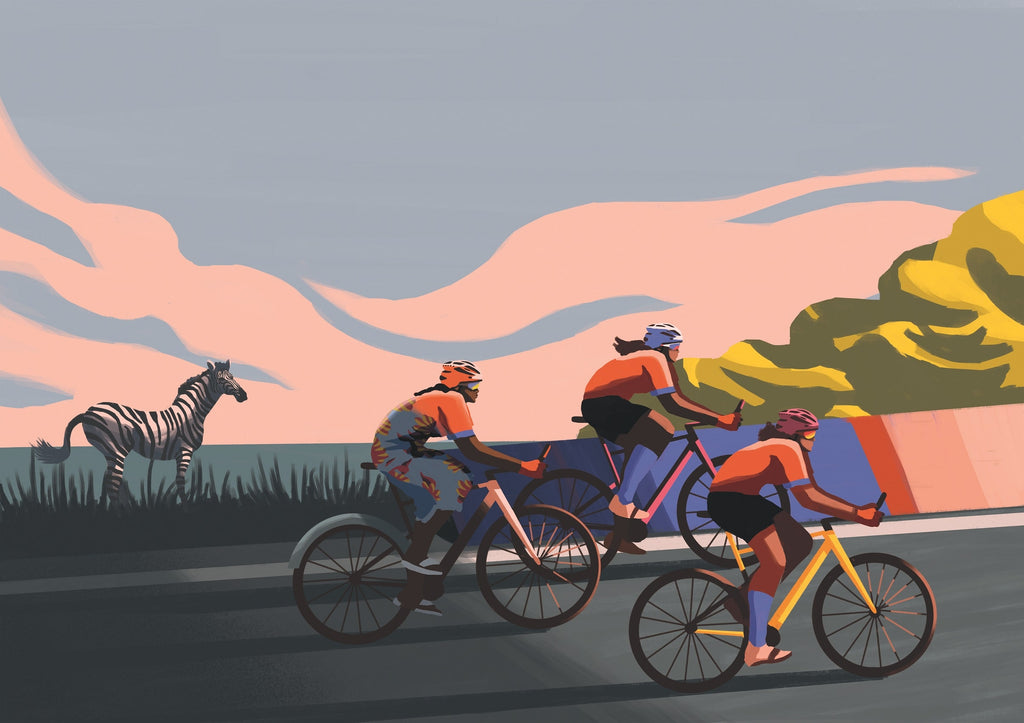Women
Eric Min - Eric is the co -founder and CEO of Zwift. The inaugural Tour de France Femmes avec Zwift will be held in July 2022.
“Zwift is a great way to connect with communities and build new ones, to break down some of the barriers that exist in the real world. We’ve been doing that for eight years.
“We’ve chosen to double down on women’s cycling be- cause we think there’s a huge opportunity to help grow that space. Starting with professional cycling, leveraging the Tour de France platform and really promoting it in a number of different ways. Wage equality: in the events we’ve done with women and men, we’ve tried to be equal in every aspect – distance, prize money, broadcast coverage. I think by working with ASO and promoting women’s cycling, it’s going to have this trickle-down effect of bringing more people into the sport – both men and women, but more specifically, women.
“To be pretty transparent, only 20 per cent of our community is made up of women. Why couldn’t it be similar to running, where it’s more 50-50? And there are real reasons why fewer women are getting into the sport of cycling. There’s the danger aspect. Clubs tend to be predominantly men. And so there’s a lot of emphasis on our platform to create all-women clubs, and I think that’s naturally going to extend to the same in the real world.
“You need to create heroes. So investing in professional women’s events, like the women’s Tour de France at the top, is a perfect starting point. Then it would be followed by more sponsorship dollars that will hopefully create more grassroots programmes to find those athletes – you cannot grow anything without that. And the Zwift Academy, trying to find talent, is part of that.
“The women’s Tour de France will spur on little girls wanting to compete there, aspiring to be those athletes. We need to make those heroes through these events, through broadcast television, through sponsorship.
Hopefully one of these days, we will create the Serena Williams or Simone Biles of cycling. And hopefully, ten to 15 years from now, when we look back, people could recognise Zwift as being the catalyst for embracing diversity and just growing the whole space, the whole activity of cycling. That would be a proud moment for all of us.”

Broadcasting
Matteo Trentin - Matteo is a professional cyclist with UAE Team Emirates and vice-president of the ACCPI, the association of Italian professional cyclists.
“We all have power, heart- rate, speed and GPS data that we could broadcast. They don’t show much of it currently, though I don’t know exactly how that works. There’s a lot of ways to use these things and with commentators who can understand and explain, it would be very interesting: why this rider does that, why a certain team has these tactics.
“If you see motorsports, they basically made the sport better with data. Especially Formula 1. My oldest kid is really into it, so we saw all of the first series of Netflix’s Drive to Survive. They made a quite boring championship, with Lewis Hamilton starting first and seeing everyone again at the finish, into something really fascinating – you see backstage and inside the Grand Prix. With us cyclists, you never see what’s happening before or after the race. Some people are surprised when I say that the Tour, Giro or Vuelta doesn’t just go from A to B. Our hotel is in C and the start is in D. Or they are unaware of the many, many people in a Grand Tour working around an eight-rider team.
“As for broadcasting race radio, it depends. Sometimes in the heat of the moment, you say something that isn’t nice to hear live on television. But with a moderator and doing it post-race, why not?
“We need the right people interested in this sport to invest. It could be a winter series from the Tour de France or the Classics, giving people some backstage footage to watch, understanding a little more of why the race went this way and the team environment. Of course it has its own costs and there’d be a system to implement, but I think it would be the next step for the broadcasting of cycling. We need to involve people like Netflix, Amazon, whatever the pay-per-view channel is. They’re really taking the place of normal television.”
Diversity
Christine Kalkschmid - Christine is a lawyer, athlete and health and nutrition coach. She is helping women’s WorldTour team Canyon-SRAM to develop a comprehensive diversity and inclusion programme.
“We need to make cycling truly diverse and inclusive. We need to educate people, but also make bike racing more accessible, especially to those from nations that are currently un- der-represented in the peloton. For instance, by pursuing non-traditional development paths. As a result, the main goal is to provide equal opportunities, then the most talented rider in the end will come out on top, independent of their background, their country of origin, their financial situation or the colour of their skin.
“If we start at the base, then simply, we have quite a high entrance barrier to get into cycling. Whenever I want to go running, I just need shoes, or maybe I don’t even need shoes. If I want to ride a bike, I need to have access to a bike. If I want to race, I need to have access to a more expensive bike, a better bike. If I want to race professionally, I need to find a path to come to Europe. We need to look at the whole topic from the top down. Assuming I put myself in the shoes of a young talented rider from Africa: I’m passionate about riding a bike and I’m privileged compared to where I am. I have a bike and I can ride a bike, but the only thing I see is white women in the peloton, and the podium is only white women from Europe. So does this give me a real sense of belonging? Probably not. Probably I’m rather frustrated, discouraged and might think: is this really a sport for me?
“We’re mainly focusing on Africa, South America and Asia with Canyon-SRAM’s new development team, because these are the continents that are under-represented in the peloton. The riders will have guided training, mentorship, soigneurs and mechanics. They’ll learn everything that is needed to be a professional bike rider. Our belief is that if we provide these equal opportunities, then we’ll find talents that are able to step up to work through teams that otherwise wouldn’t have the chance because they didn’t get the support needed.
“In Canyon-SRAM, I’m this outside person that tells the riders in the team about diversity and inclusion, which they thought wasn’t really relevant to them. This is actually typical. I don’t mean that in a negative way, but when you belong to a majority in a group – in this case, white female riders from Europe or America and Australia – none of the under-represented countries, no people of colour, then you don’t really see a lack of diversity. I had to help them to step into the shoes of somebody else, then take another look and then re-discuss how diverse or inclusive cycling is.
“It is definitely a long-term project. There are no quick fixes. It’s not only about educating, it’s about understanding, and incorporating it in every single thing you do. This is something that takes time. I mean, changing the world of cycling, this is a huge goal.”

Industry
Will Butler-Adams - Will is CEO of folding bike specialists Brompton, Britain’s largest volume manufacturer of bicycles.
“I think you need to start with the industry. It has been selling to cyclists for the last 50 or more years. Go to a traditional bike shop and it’s techy, it’s geeky, it’s full of nine-speed Shimano whatever; hard-tail, soft-tail, fat-tail, this size rim, that size sprocket. You’re talking to cyclists [the staff], and in many respects, that’s a bit intimidating. In London, 4.5 to 5 per cent are cyclists – some- body who rides their bike two or three times a week – and in New York, it’s less than 1.5 per cent. I could go on...
“But then you ask the question: how many people in New York know how to ride a bike? Well, that’s 90 to 95 per cent. In London, it’s something similar. So who do you want to talk to? The cyclist, or the person who knows how to ride a bike?
“If you understand that what you are trying to do is engage the person who knows how to ride a bike but isn’t, then you approach it the same way that any other retailer does – with a less intimidating, inviting environment. You need to show them themselves in other people doing that activity. If all your marketing is hardcore, super-lean, unbelievably fit Tour de France cyclists, they are going to look at the picture and think, I could never do that, this person is unbelievable. Make it normal, make it inviting, break down the barriers to entry.
“That’s what we have done as a brand. But at a macro level, you need government to improve infrastructure, because the real fear is that pedalling down the road with a little white line between you and a two-ton truck is a little bit weird. What you want is a segregated cycle lane and then you find that parents are cycling with their children to school. And that is a government priority in investment that we are seeing more and more. We need it more quickly, but at least it is happening. There is a transformation of focus in terms of what cycling can do for cities.”

Integration
Hannah Dines - Hannah is a T2 tricycle racer and Team GB Paralympian.
“We need integration. Every time there is an able-bodied event with all different types of cycling, I want there to be para-cycling alongside it. I want cycling fans to see the sport side by side: my cycling is no different to the cycling you enjoy. Glasgow is going to be the first to do it, hosting the 2023 World Championships with road, para-cycling, track cycling, mountain bike, BMX, everything. It’s actually easier to set up and there will be a way of doing it that is cost-effective.
“We have our own para-cycling nationals and we’ve never had a closed road event, we never get crowds. In general, there’s never prize money either, because of the lack of interest and coverage. And if we got integrated events, that would change.
“Right now, in terms of British para-cycling, we have fewer and fewer events because fewer people turn up. So, in terms of organisation, I’d say start at a small, nation- al level, put on a closed road event and you will get every- body turning up. For example, one time we accidentally had Bradley Wiggins racing in the event just after ours. It was in Abergavenny, in 2014, and everyone was there. And that was just because of timing. The spectators didn’t realise that they were going to watch a para-cycling race and they were hammering on the side of the barriers. The feeling of joy that I had was incredible.
“There are so many barriers to my sport, in terms of people not understanding how it works. In fact, just people knowing it exists and seeing how cool it is, would be amazing. I think you gain so much more by enjoying cycling in all its diversity.”
Illustrations by Gastón Mendieta






























